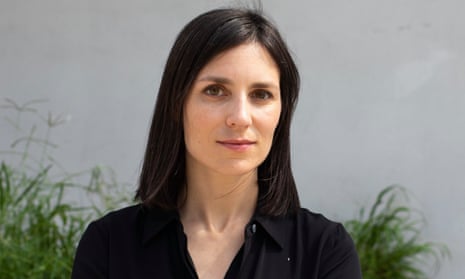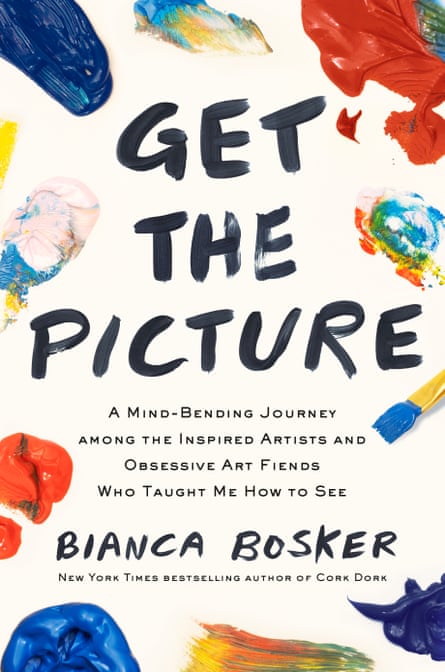| The Kicker |
UNCOVERING ART SPEAK. For her new book, “Get the Picture,” author Bianca Bosker gives an irreverent account of working in New York’s art scene, including entry jobs at Gagosian Gallery, as a studio assistant, and a guard at the Guggenheim Museum. In her attempt to uncover the inner workings and code-filled language of the contemporary art world, “I felt like an FBI agent showing up for a job interview with the mob,” she told The Guardian . “These gatekeepers become a lot more important if we’re told we can’t understand art without spending years at art fairs, getting a master’s degree, memorizing the encyclopedia of artists and wearing the right jeans,” Boserk said. With her book, she hopes to demonstrate the opposite is true. |

‘I felt like an FBI agent’: the author who infiltrated the art world
Cork Dork author Bianca Bosker has turned her gaze toward art with her new book, trying to immerse herself in a world that wanted nothing to do with her
There are few more self-congratulatory terms in the world of journalism than the “deep dive”, but Bianca Bosker has earned the right to get those two words tattooed on any body part of her choosing. She doesn’t sit with and sift through her material so much as plunge headlong into it, gatecrashing cloistered ecosystems that want nothing to do with her, and emerging as a foremost expert. In her 2017 debut Cork Dork, Bosker was brave enough to infiltrate the realm of wine snobs and attempt to pass the notoriously difficult sommelier test (spoiler alert: she succeeded). The latest object of the New Yorker’s fascination – and frustration – is the realm of contemporary art, a micro-society populated by uber-cool gallerists, uber-rich collectors, and the countless starving artists and sad-sack wannabes firing up their Seesaw apps and trying to cram 15 gallery openings into one Thursday night.
“It took over my life,” is how she puts the process of reporting Get the Picture, her plucky and hilarious account of years working as a gallery girl, studio assistant, and guard at the Guggenheim Museum. “I don’t think that at the outset I had any idea the extent to which it would take over my life, or the length of time it would take over my life.” Part of the problem was getting access. “I felt like an FBI agent showing up for a job interview with the mob,” she says of her efforts to win over art world sources. The message she kept hearing was: back off. There were even threats. “They didn’t come right out and threaten my safety or anything,” Bosker says. “But my reputation, wellbeing, and livelihood as a journalist – that was another story.” When some people got wind of her project, they indicated that if she went through with it, they’d better like every word they read.
Their anxiety makes a certain sense. As Bosker’s book lays out, the art world depends on a web of secrecy to protect a select few’s social and economic capital, and to justify astronomic price tags. “These gatekeepers become a lot more important if we’re told we can’t understand art without spending years at art fairs, getting a master’s degree, memorizing the encyclopedia of artists and wearing the right jeans,” Bosker says.
As she studied the art world’s Bat-Signals and argot, she started to collect friends and learn to speak their language. Not that it was easy. Even though her inquiries were entirely innocuous, few would provide direct answers. Instead, her curiosity was met with criticisms, even by those who agreed to spend time with her. She asked too many questions. Her clothes were too boring. Her emails were too long and made her sound too unimportant. Her resting bitch face was entirely hopeless.

In her book, she dares to break down the strange codes and customs of the contemporary art world – why, for instance, it is entirely gauche to call something “beautiful” or why must gallerists say they “placed” a painting rather than announce that they “sold” it? “Artspeak is an exclusionary code where every word needs to be bigger than it should be,” she explains. “The more syllables the better. There’s this needlessly complex way of discussing everything, and in a voice that makes you sound like you’re running out of batteries.” If you read an artist’s statement and wonder why it doesn’t sound like normal English, Bosker has a theory for you: she posits that Artspeak emerged in the 1970s when critics were trying to emulate the clunkily translated essays of French academics.
But her intention wasn’t to poke fun at a society that some regard as an espresso-addled punchline. Growing up, she was a gifted artist and even considered becoming an artist before she got swept up in getting As in college. Now 37, she wanted to learn about a fundamental joy that she’d lost along the way. Every time she went to look at art, her gaze gravitated toward the wall text. She sensed that she was missing out on a world of emotion and expression that existed right before her eyes. “I felt like I had gravely misunderstood something crucial to my humanity,” she says.
Her determination prevailed and she talked her way into shadowing insiders, painting gallery walls, stretching canvases, and being their plus one at parties. She spent time with an edgy gallerist, a pair of slightly less edgy gallerists, and museum guards. She got lost in the weeklong slipstream of the Miami Art Fair (where she cosplayed as a gallery associate and made an impressive slew of sales). She also apprenticed with the artist Julie Curtiss and Mandy allFIRE, an internet-famous performance artist whose work involves grooming her derriere and sitting on things and people (Bosker won her over at a Gowanus happening when she allowed the artist to rest her pneumatic body on top of her).
The more time Bosker spent reporting, the more obvious it became that when people talked about art, they were often talking about everything but the work itself. In a world where a painting can sell for $1,200 only to be flipped two years later at an auction for $600,000, context is king. As Bosker breaks down for her reader, this means where an artist went to grad school, who they are friends with, where they have shown their work before, who has graced them with a “studio visit” (whatever that means), all come into play.
“I had a gallerist pitch me on someone’s work by being like, oh, like he’s sleeping with a much more famous artist,” Bosker recalls. “There’s this implication that you can’t possibly understand a piece unless you, you know, spent years reading Clement Greenberg, you know, steeped in art fairs, like, you know, and like memorizing, like the social networks on the Lower East Side. As one gallerist told me, if you don’t understand the context, you can’t understand what the fuck you’re looking at.”
Turned off by this message, she doubled down, working on educating herself. She wanted to understand how art is made, and train her eye to see things in new ways. “Spending time with artists in their studios and talking me through their decisions showed me something different. That everything that you need to have a meaningful experience with art is right in front of you.”
Bosker’s book takes an alternately side-eyed and wide-eyed approach. “I came away from this experience feeling like the velvet ropes and the made-up language and the kind of deliberate mean streak is unnecessary,” she says. “Art can move us and can stand on its own two feet, it can move us without the elaborate secrecy and snobbery.”
These days, she says, she finds art in unlikely places – say, the sight of steam escaping a sidewalk vent or a fleet of Mr Softee ice-cream trucks idling on a street corner. She is more attuned as a writer, too, more patient and observant. “Our brains are like trash compactors,” she says. “The way that we perceive the world involves condensing information and compressing information. And I think looking at art is training for taking in the full beauty and chaos of the world around us.”
Get the Picture is out on 6 February
Well, 2023 didn’t exactly go to plan, did it?
Here in the UK, the prime minister, Rishi Sunak, had promised us a government of stability and competence – not forgetting professionalism, integrity and accountability – after the rollercoaster ride of Boris Johnson and Liz Truss. Remember Liz? These days she seems like a long forgotten comedy act. Instead, Sunak took us even further through the looking-glass into the Conservative psychodrama.
Elsewhere, the picture has been no better. In the US, Donald Trump is now many people’s favourite to become president again. In Ukraine, the war has dragged on with no end in sight. The danger of the rest of the world getting battle fatigue and losing interest all too apparent. Then there is the war in the Middle East and not forgetting the climate crisis …
But a new year brings new hope. There are elections in many countries, including the UK and the US. We have to believe in change. That something better is possible. The Guardian will continue to cover events from all over the world and our reporting now feels especially important. But running a news gathering organisation doesn’t come cheap.
So this year, I am asking you – if you can afford it – to give money. Well, not to me personally – though you can if you like – but to the Guardian. The average monthly support in Portugal is around €3, however much you give, all that matters is you’re choosing to support open, independent journalism.
With your help, we can make our journalism free to everyone. You won’t ever find any of our news reports or comment pieces tucked away behind a paywall. We couldn’t do this without you. Unlike our politicians, when we say we are in this together we mean it.
Happy new year!
John Crace
Guardian columnist
























No comments:
Post a Comment